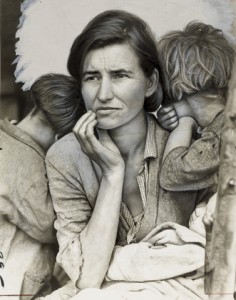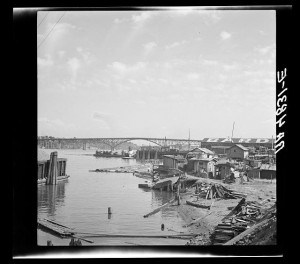Life During the Great Depression
When studying the Great Depression, it is important to no only look at the political and economic factors, but also the social history. Studying how people lived their lives and how they survived opens a new door into the history of the Depression. Already, many people have chosen to study this topic, however they’ve focused on certain aspects of it; pertaining to music or the Dust Bowl, this research guide provides a comprehensive look at potential paper encompassing all aspects of life. Focusing on life during the Great Depression, the information spans from 1929 to the early 1940s, before World War II. The guide is based on what life was like, ranging form personal experiences, to entertainment and other forms of distraction. One of the more interesting aspects of the guide is focusing on the lives of children, who were forced to grow up in a matter of years. It provides a better understanding for the older generation today, which is why we study history.
General History
The PBS article describes the general timeline and events of the Great Depression. It recognizes the discrepancy in wealth, the debt and stock crisis. It also briefly describes the political situation, including Hoover’s lack of intervention and Roosevelt’s New Deal.
“Surviving the Dust Bowl: The Great Depression.” PBS. Accessed December 11, 2014.
http://www.pbs.org/wgbh/americanexperience/features/general-
article/dustbowl-great-depression/.
Hoover’s Presidential Library provides general information as to why the Great Depression occurred and the fact that there was little to no way to prevent it. It also talks about the economics of the situation and what could, or could not, have been done.
“The Museum Exhibit Galleries.” The Herbert Hoover Presidential Library and
Museum. http://www.hoover.archives.gov/exhibits/Hooverstory/gallery06/
index.html.
Life
The video by the US National Archives describes the familiar situation that many families suffered during the Depression. It also provides clips of survivors who grew up. With photos of the poverty in the background, the interviewees describe how they and their families dealt with the Depression.
“US National Archives: Stories from the Great Depression.” YouTube. June 15, 2009.
Accessed December 2, 2014.
https://www.youtube.com/watch?v=TpfY8kh5lUw.
Stories From the Great Depression
This article concentrates on the hardships many farmers faced post WWI leading into the Great Depression. Coming off the economic surge from the war, prices sky rocketed as Europeans were no longer importing goods. However, farms continued to die, and with the Dust Bowl, nothing was left. Although the article also acknowledges that city life was not much easier.
“The Great Depression Hits Farms and Cities in the 1930s « Iowa Pathways.” Iowa
Public Television: Iowa Pathways. Accessed December 2, 2014.
http://www.iptv.org/iowapathways/mypath.cfm?ounid=ob_000064.
Hoovervilles and Homelessness describes the shack towns, best known as Hoovervilles that sprung up across America during the Depression. Also providing photographs, it describes the dismal living conditions of the countless family living there.
“Hoovervilles and Homelessness.” The Great Depression in Washington State.
Accessed December 2, 2014.
http://depts.washington.edu/depress/hooverville.shtml.
The Library of Congress’ photo library of Hoovervilles shows the true living conditions of Americans as the Depression waged on and President Hoover did nothing; therefore, Americans named the poor, dirty and sad homes after him.
Children
This book, although geared towards a younger audience, provides great insight into the lives of the children of the Great Depression. Through the use of photos, personal accounts and other historical facts, Freedman allows the reader to experience the life of an average child and their hardships in this period.
Freedman, Russell. 2005. Children of the great depression. New York: New York :
Clarion Books.
This Marquette University student’s paper, which is brief yet informative, provides an insight into the lives of children during the depression. It acknowledges that many were devoid of education, meals and stable homes. Also, it talks about teenagers “riding the rails” or teenagers who, in an attempt to relieve their parents of the burden of caring for a child, jumped on trains and went off in search of their own lives.
“Life During the Great Depression.” Marquette University: Western Civilization.
Accessed December 2, 2014. http://academic.mu.edu/meissnerd/depression.htm#Abstract.
This book gives readers an interesting view into the minds of the youth during the Great Depression. Some wrote to her asking for support and thanking her for being so kind to the poor, while others bitterly questioned her ability to understand, seeing that she was not personally affected by the depression. It also explains the setting these children were raised in providing statistics of unemployment and poverty.
Cohen, Robert (Robby), Eleanor Roosevelt, Robert Cohen, and ebrary provider.
2002. Dear Mrs. Roosevelt: Letters from children of the great depression.
Chapel Hill: Chapel Hill : University of North Carolina Press.
The video, Childhood Lost: An Overview of the Great Depression, describes and shows the changes in childhood as the depression engulfed America. Children dropped out of school and had to learn to care for themselves. The video describes how families had no support from anyone, and 250,000 teenagers traveled the rails in an attempt to help and find jobs.
“Childhood Lost: An Overview of the Great Depression.” YouTube. June 9, 2010.
Accessed December 2, 2014.
https://www.youtube.com/watch?v=pNOT4fWPOSc#t=19.
Childhood Lost: An Overview of the Great Depression
Working
This columnist briefly recounts the story of a man who went on strike during the Great Depression. When the strike was over, the man had only increased his wages by $1.50 a week; however, this money allowed him to provide better meals and shoes to his family. The article demonstrates what working in the Great Depression was like, how living off $78.00 a year was considered a blessing.
Stroock, Mark. 1988. Happiness for $ 1.50. Advertising Age 59 (15): 38.
In Voices from the Dust Bowl, photos and newspaper clippings describe the hardships farmers faced attempting to survive the Depression. Attempting to form union, reach out to the government and some migrating, the newspapers reported the growing frustration and poverty in the Dust Bowl area.
Voices from the Dust Bowl.” Library of Congress. Accessed November 19, 2014.
bin/ampage?collId=afcts&fileName=sb001/sb001.db&recNum=20.
Death Rates
A surprising fact of the depression is that the mortality rate did not increase during the depression; in fact, it decreased. The only increasing rate was the suicide rate, which accounted for 2% of all deaths. Life and Death During the Great Depression provides comprehensive analysis of the rates and statistics of death.
Granados, Jose A. Tapia. “Life and Death during the Great Depression.” Proceedings
Of The National Academy Of Sciences Of The United States Of Ame, no. 41
(2009): 17290-7295.
Another source that coincides with Life and Death During the Great Depression is Great Depression Had Little Effect on Death Rates. The article acknowledges that mortality rates decreased, but also suggests that it could be because of improvements in health care. The article implies the superior medical care, but also conveys the stress of the time, acknowledging that suicide levels rose.
Zielinski, Sarah. “Great Depression Had Little Effect on Death Rates.” Smithsonian. March 28, 2011. Accessed December 1, 2014.
Personal Stories
The NPR interviews of survivors of the Great Depression offer a personal and incomparable glimpse into the lives of those living in Chicago during the 1930s. Four people who lived during the depression describe their situations as children during the time. Although the memories are some of the toughest, they also look back fondly on some memories and have learned the true value of money.
Ellis, Neenah. “Surivors Of The Great Depression Tell Their Stories.” Narrated by
Michele Norris. NPR, November 27, 2008. http://www.npr.org/templates/story/story.php?storyId=97468008
In The Family of an Automobile Worker, a wife and mother is interviewed about her family, home and money during the depression. She talks about making the choice between having a home or a car, providing health insurance for her children and the money made through her tenants. An interesting aspect of the story is that her husband allows her to control the money from the tenants, which is interesting when considering the gender roles of the time.
“A Georgia Auto Worker and His Family – American Memory Timeline- Classroom
Presentation | Teacher Resources – Library of Congress.” Library of Congress. Accessed December 3, 2014. http://www.loc.gov/item/wpalh000568
The Role of Entertainment (Art, Music, Movies, Literature, Etc.)
Entertainment provided a lifeline for countless Americans throughout the Great Depression. One of the most influential members of the industry was Shirley Temple. In the USA Today article, How Shirley Temple got America to stand up and cheer, the article describes the spirit Temple, among others, gave America. Her songs and dances encouraged Americans to keep fighting.
Desowitz, Bill. “How Shirley Temple Got America to Stand up and Cheer.” USA
Today. April 12, 2014. Accessed December 2, 2014.
http://www.usatoday.com/story/life/books/2014/04/12/the-little-girl-
who-fought-the-great-depression-shirley-temple-and-1930s-
america/7515875/.
Similarly, the Wizard of Oz also plays an important role in relating to Americans during the depression. In the BBC article, Secrets of the Wizard of Oz, the underlying political, economic and social motivations behind the book are discussed. In the midst of the depression, Dortohy is swept away from hardship to a magical world. It provided Americans with the opportunity to escape as well.
Jahangir, Rumeana. “Secrets of the Wizard of Oz.” BBC News. March 17, 2009.
Accessed November 17, 2014.
http://news.bbc.co.uk/2/hi/uk_news/magazine/7933175.stm.
The Smithsonian’s quick video about the famous “ruby slippers” explains that the shoes represent the true core of American culture. Initially, the shoes were going to be silver, but were changed to red in order to promote “fantasy” for the viewers.
“The Ruby Slippers.” The Smithsonian. Accessed November 16, 2014.
http://link.brightcove.com/services/player/bcpid693388156001?bckey=AQ
~~,AAAAABZ1xXA~,BhTgkJ7K1mYr8ERVUqqtI5vER__l-mqk&bctid=645200878001.
The University of Washington’s website, The Great Depression in Washington State, describes the resurgence of art, especially with the New Deal. It allowed new artists to thrive on their surroundings and learn how to express the daily lives of those around them, and the conditions they were living in.
“Culture and Arts during the Depression.” University of Washington. Accessed
November 16, 2014.
http://depts.washington.edu/depress/culture_arts.shtml.
In Smithsonian Folkways, Songs from the Depression, the band, The New York City Ramblers’, songs are provided. The lyrics of the songs describe the Depression and the effects it had on communities. Some of the titles also demonstrate what music did for society, like the song “Keep Moving”. The song questions how to keep going when there is not much to go forward to.
“Songs from the Depression.” Smithsonian Folkways -. Accessed November 11,
2014. http://www.folkways.si.edu/the-new-lost-city-ramblers/songs-from-
the-depression/american-folk-historical-song-old-time-struggle-
protest/music/album/smithsonian.
In the review of the book, His Side of Despair: How the Movies and American Life Intersected during the Great Depression, Anne Morey describes how film tended mirrored the times. At the time, as gender roles shifted, the romantic comedies portrayed both males and females as “bread winners”. The films demonstrate how film represented the times and how people lived.
Morey, Anne. “Project MUSE – This Side of Despair: How the Movies and American
Life Intersected during the Great Depression (review).” Project MUSE – This
Side of Despair: How the Movies and American Life Intersected during the
Great Depression (review). January 1, 2009. Accessed November 23, 2014.
http://muse.jhu.edu/journals/south_central_review/v026/26.1-
2.morey.html.
Photos
President Roosevelt’s photo library provides a glimpse into the lives of Americans during the Depression. Photos of the Dust Bowl sweeping over the farmlands and Americans heading off to work are firsthand accounts of the Depression
“Image Thumbnails | Franklin D. Roosevelt Presidential Library & Museum.”
Franklin D. Roosevelt Presidential Library & Museum.
http://www.fdrlibrary.marist.edu/archives/collections/franklin/index.php?p=digitallibrary/thumbnails&subjectid=7.
Dorothea Lange photographed countless Americans and settings throughout the Deprerssion, and some of the most recognized photos are her work. The MoMA’s collection of her works shows the shocking and capitivating images of life during the 1930s.
“The Collection: Dorothea Lange.” MoMA.org. January 1, 2009.
http://www.moma.org/collection/browse_results.php?artistFilterInitial=&c
riteria=O:AD:E:3373&page_number=1&template_id=10&sort_order=1.
“Hoovervilles During the Great Depression – American Memory Timeline- Classroom
Presentation | Teacher Resources – Library of Congress.” Library of Congress.
Accessed December 2, 2014.
http://www.loc.gov/teachers/classroommaterials/presentationsandactivitie
s/presentations/timeline/depwwii/depress/hoovers.html

